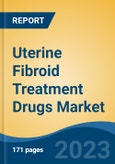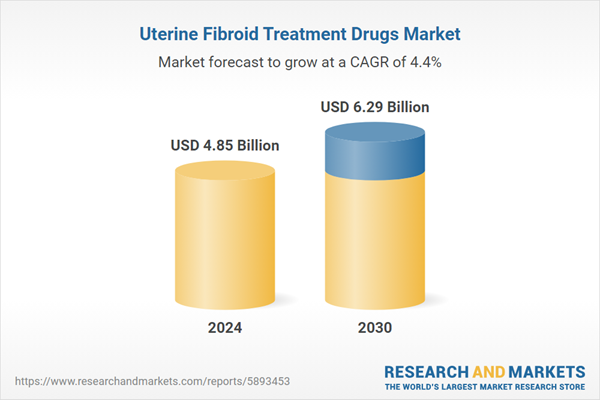Free Webex Call
The Uterine Fibroid Treatment Drugs Market was valued at USD 4.85 Billion in 2024, and is expected to reach USD 6.29 Billion by 2030, rising at a CAGR of 4.40%. Market expansion is being driven by several key factors, including the rising global prevalence of uterine fibroids, increasing preference for non-surgical treatment options, advancements in pharmaceutical research, and greater accessibility to healthcare services. Uterine fibroids, also referred to as leiomyomas, are among the most common benign tumors affecting women of reproductive age and are often associated with heavy menstrual bleeding, pelvic pain, and fertility complications. Speak directly to the analyst to clarify any post sales queries you may have.
10% Free customizationThis report comes with 10% free customization, enabling you to add data that meets your specific business needs.
Growing awareness, improved diagnostic practices, and expanded access to treatment have accelerated the adoption of pharmacological therapies. This is particularly evident in the increasing use of gonadotropin-releasing hormone (GnRH) antagonists, progestin-based regimens, and non-hormonal alternatives, reflecting a broader shift in patient preference toward non-invasive therapies over surgical procedures. Ongoing drug innovations, higher regulatory approval rates, and expanding insurance coverage continue to support the market’s positive outlook, especially in regions witnessing a surge in fibroid incidence and improved access to care.
Key Market Drivers
Rising Prevalence of Uterine Fibroids
The increasing global prevalence of uterine fibroids is a primary growth driver for the market. These benign pelvic tumors, although non-cancerous, are widespread among women of reproductive age. Due to their frequently asymptomatic nature, actual prevalence is likely underreported. Studies indicate a wide prevalence range from 4.5% to 68.6%, influenced by variables such as diagnostic methods, population demographics, and healthcare availability.As the number of diagnosed cases continues to rise, so does the demand for effective pharmacological treatment. Factors such as late pregnancies, hormonal imbalances, and a global increase in obesity contribute significantly to the growing incidence of uterine fibroids. For instance, in 2022, one in every eight individuals globally was affected by obesity. Since 1990, obesity rates have more than doubled in adults and quadrupled in adolescents, with 2.5 billion adults classified as overweight, including 890 million with obesity. These health trends further amplify the burden of uterine fibroids and underscore the demand for scalable, non-invasive treatment solutions.
Key Market Challenges
Limited Long-Term Efficacy and Safety Data
While pharmaceutical treatments for uterine fibroids have demonstrated notable effectiveness in managing symptoms, concerns remain regarding their long-term safety and efficacy. Many clinical studies feature relatively short follow-up periods, limiting insights into extended use and sustained outcomes. To ensure continued patient trust and optimize treatment strategies, robust long-term clinical data is essential. Such data will help address safety concerns, inform regulatory decisions, and guide healthcare providers in making evidence-based therapeutic choices.Key Market Trends
Emergence of Combination Therapies
The market is witnessing a growing interest in combination therapy approaches, integrating uterine fibroid drugs with minimally invasive procedures or complementary hormonal treatments. These integrated solutions offer the potential for enhanced symptom relief, improved patient outcomes, and a more personalized treatment experience.Combination therapies are especially promising for patients with varying fibroid types, sizes, or symptoms, allowing for tailored care strategies that target fibroids through multiple mechanisms. This approach not only improves therapeutic efficacy but also reduces the likelihood of recurrence, positioning combination treatment as a compelling solution in the evolving landscape of uterine fibroid care.
Key Market Players
- Myovant Sciences Ltd
- Pfizer Inc
- Abbvie Inc
- Ferring BV
- AstraZeneca
- Bayer AG
- Amring Pharmaceuticals Inc
- Watson Pharma Pvt Ltd
Report Scope:
In this report, the Global Uterine Fibroid Treatment Drugs Market has been segmented into the following categories, in addition to the industry trends which have also been detailed below:Uterine Fibroid Treatment Drugs Market, By Drug Class:
- Gonadotropin-Releasing Hormone (Gnrh) Agonists
- Gonadotropin-Releasing Hormone (Gnrh) Antagonists
- Progestin-Releasing Intrauterine Device (Iud) & Contraceptives
- Non-Hormonal Medications
- Others
Uterine Fibroid Treatment Drugs Market, By Type:
- Subserosal Fibroids
- Intramural Fibroids
- Submucosal Fibroids
- Pedunculated Fibroids
Uterine Fibroid Treatment Drugs Market, By End User:
- Hospital Pharmacies
- Retail Pharmacies
- Others
Uterine Fibroid Treatment Drugs Market, By region:
- North America
- United States
- Mexico
- Canada
- Europe
- France
- Germany
- United Kingdom
- Italy
- Spain
- Asia-Pacific
- China
- India
- South Korea
- Japan
- Australia
- South America
- Brazil
- Argentina
- Colombia
- Middle East & Africa
- South Africa
- Saudi Arabia
- UAE
- Kuwait
Competitive Landscape
Uterine Fibroid Treatment Drugs Market.Available Customizations:
With the given market data, the publisher offers customizations according to a company's specific needs. The following customization options are available for the report.Company Information
- Detailed analysis and profiling of additional market players (up to five).
This product will be delivered within 1-3 business days.
Table of Contents
1. Product Overview
2. Research Methodology
3. Executive Summary
5. Clinical Trial Analysis
6. Global Uterine Fibroid Treatment Drugs Market Outlook
7. North America Uterine Fibroid Treatment Drugs Market Outlook
8. Europe Uterine Fibroid Treatment Drugs Market Outlook
9. Asia-Pacific Uterine Fibroid Treatment Drugs Market Outlook
10. South America Uterine Fibroid Treatment Drugs Market Outlook
11. Middle East and Africa Uterine Fibroid Treatment Drugs Market Outlook
12. Market Dynamics
13. Market Trends & Developments
15. Porter’s Five Forces Analysis
16. Competitive Landscape
Companies Mentioned
- Myovant Sciences Ltd
- Pfizer Inc
- Abbvie Inc
- Ferring BV
- AstraZeneca
- Bayer AG
- Amring Pharmaceuticals Inc
- Watson Pharma Pvt Ltd
Table Information
| Report Attribute | Details |
|---|---|
| No. of Pages | 180 |
| Published | April 2025 |
| Forecast Period | 2024 - 2030 |
| Estimated Market Value ( USD | $ 4.85 Billion |
| Forecasted Market Value ( USD | $ 6.29 Billion |
| Compound Annual Growth Rate | 4.4% |
| Regions Covered | Global |
| No. of Companies Mentioned | 8 |









